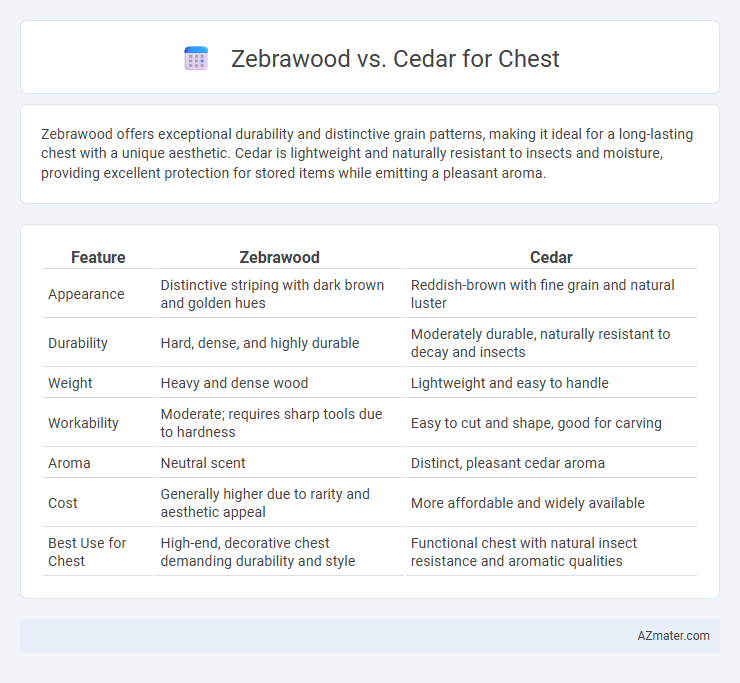Zebrawood offers exceptional durability and distinctive grain patterns, making it ideal for a long-lasting chest with a unique aesthetic. Cedar is lightweight and naturally resistant to insects and moisture, providing excellent protection for stored items while emitting a pleasant aroma.
Table of Comparison
| Feature | Zebrawood | Cedar |
|---|---|---|
| Appearance | Distinctive striping with dark brown and golden hues | Reddish-brown with fine grain and natural luster |
| Durability | Hard, dense, and highly durable | Moderately durable, naturally resistant to decay and insects |
| Weight | Heavy and dense wood | Lightweight and easy to handle |
| Workability | Moderate; requires sharp tools due to hardness | Easy to cut and shape, good for carving |
| Aroma | Neutral scent | Distinct, pleasant cedar aroma |
| Cost | Generally higher due to rarity and aesthetic appeal | More affordable and widely available |
| Best Use for Chest | High-end, decorative chest demanding durability and style | Functional chest with natural insect resistance and aromatic qualities |
Introduction: Comparing Zebrawood and Cedar for Chests
Zebrawood offers a distinctive, bold striped grain pattern with high durability, making it ideal for statement chests that require both strength and aesthetic appeal. Cedar is prized for its natural resistance to moisture, insects, and pleasant aromatic qualities, ensuring long-lasting protection and a fresh scent in storage chests. Choosing between Zebrawood and Cedar depends on prioritizing either unique visual impact and hardness or natural preservation and fragrance.
Appearance and Grain Patterns
Zebrawood features bold, dark stripes on a pale golden-yellow background, creating a striking contrast ideal for statement chests. Cedar exhibits a rich reddish-brown hue with straight, fine grain patterns that offer a warm, classic appearance. The dramatic zebra striping lends a contemporary edge, while cedar's uniform grain provides a timeless, elegant look.
Durability and Strength
Zebrawood offers exceptional durability and strength, making it highly resistant to wear, impact, and decay, which is ideal for sturdy chest construction. Cedar, while softer and lighter, provides moderate durability with excellent natural resistance to moisture and insect damage, ensuring long-lasting protection. Choosing Zebrawood results in a more robust chest capable of withstanding heavy use, whereas Cedar offers a balance of durability and easier workability for decorative storage.
Scent and Aromatic Qualities
Zebrawood offers a subtle, sweet, and slightly peppery aroma that enhances the sensory experience of a chest, making it ideal for furniture where mild scent is desired. Cedar releases a strong, fresh, and distinctive fragrance rich in natural oils like thujone, known for its insect-repellent properties and long-lasting aromatic presence. Choosing cedar for a chest provides both a pleasant pine-like scent and functional benefits, whereas zebrawood is favored for its elegant grain pattern with a more understated aroma.
Resistance to Pests and Decay
Zebrawood offers moderate resistance to pests but is more prone to decay compared to cedar, making it less ideal for environments with high moisture or insect activity. Cedar excels in natural durability, showcasing exceptional resistance to both pests and decay due to its inherent oils and compounds, which deter insects and inhibit fungal growth. Choosing cedar for chest construction enhances longevity and protection, especially in humid or pest-prone settings.
Workability and Ease of Crafting
Zebrawood offers moderate workability with its dense grain requiring sharp tools and careful handling but results in a smooth finish ideal for chest crafting. Cedar is prized for exceptional workability, featuring a soft texture that cuts and shapes easily, making it preferred for intricate chest designs. While Zebrawood demands more effort and precision, Cedar provides ease and speed in crafting chests without compromising durability.
Maintenance and Care Requirements
Zebrawood requires regular oiling to maintain its vibrant grain patterns and prevent drying or cracking, while cedar naturally resists moisture and insects, reducing maintenance efforts. Cedar chests benefit from occasional sanding to manage surface wear and can be refreshed with light coats of cedar oil or beeswax. Both woods need protection from extreme humidity fluctuations to avoid warping, but cedar generally offers a more low-maintenance option for long-term care.
Cost and Availability
Zebrawood is generally more expensive than cedar due to its exotic origin and limited availability, often sourced from West Africa. Cedar is widely available and more affordable, making it a practical choice for chest construction. Cost efficiency and ease of access make cedar preferable for budget-conscious projects, while zebrawood suits premium, distinctive designs.
Environmental Impact and Sustainability
Zebrawood is often sourced from tropical regions and faces challenges related to deforestation and habitat loss, making its sustainability dependent on certified harvesting practices like FSC certification. Cedar, particularly western red cedar, tends to be more sustainable due to faster growth rates and more widespread replanting efforts, with many suppliers offering sustainably managed options. Choosing cedar wood for chests typically results in a lower environmental impact when sourced from responsibly managed forests compared to zebrawood.
Best Choice: Zebrawood or Cedar for Your Chest?
Zebrawood offers a striking, unique grain pattern and high durability, making it ideal for chests requiring both aesthetics and long-lasting strength. Cedar is highly valued for its natural aromatic properties and excellent resistance to insects and moisture, perfect for storage chests protecting contents like clothing or linens. For a balance of visual appeal and protective features, the choice depends on whether chest durability or aromatic preservation is the priority.

Infographic: Zebrawood vs Cedar for Chest
 azmater.com
azmater.com